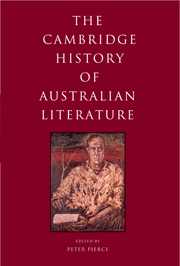Book contents
- Frontmatter
- Introduction
- FROM EUROPEAN IMAGININGS OF AUSTRALIA TO THE END OF THE COLONIAL PERIOD
- 1 Britain’s Australia
- 2 The beginnings of literature in colonial Australia
- 3 Early writings by Indigenous Australians
- 4 Australian colonial poetry, 1788–1888: Claiming the future, restoring the past
- 5 No place for a book? Fiction in Australia to 1890
- 6 Romantic aftermaths
- FROM THE LATE NINETEENTH CENTURY TO 1950
- TRAVERSES
- FROM 1950 TO NEARLY NOW
- Select bibliography
- Index
- References
6 - Romantic aftermaths
from FROM EUROPEAN IMAGININGS OF AUSTRALIA TO THE END OF THE COLONIAL PERIOD
Published online by Cambridge University Press: 28 May 2011
- Frontmatter
- Introduction
- FROM EUROPEAN IMAGININGS OF AUSTRALIA TO THE END OF THE COLONIAL PERIOD
- 1 Britain’s Australia
- 2 The beginnings of literature in colonial Australia
- 3 Early writings by Indigenous Australians
- 4 Australian colonial poetry, 1788–1888: Claiming the future, restoring the past
- 5 No place for a book? Fiction in Australia to 1890
- 6 Romantic aftermaths
- FROM THE LATE NINETEENTH CENTURY TO 1950
- TRAVERSES
- FROM 1950 TO NEARLY NOW
- Select bibliography
- Index
- References
Summary
Knowledge was never a matter of geography.
Quite the reverse, it overflows all maps that exist.
Patrick White, VossIt is a cliché of intellectual history that the United States is a product of Enlightenment optimism. ‘Next to the introduction of Christianity among mankind,’ the contemporary English commentator Richard Price argued, ‘the American revolution may prove the most important step in the progressive cause of human improvement.’ It was on the basis of a tradition of such commentary that Leslie Fiedler wrote 180 years later: ‘Insofar as America is legendary, a fact of the imagination as well as one of history, it has been shaped by the ideals of the Age of Reason.’
By contrast, Australia came into being at the end of a century of intellectual pessimism inaugurated by the counter-revolution we call Romanticism: a counter-revolution with which in substantial measure we are still coming to terms. ‘We hold these Truths to be self-evident,’ Thomas Jefferson and his co-authors of the Declaration of Independence wrote in 1776, ‘that all Men are created equal, that they are endowed by their Creator with certain unalienable Rights, that among these are Life, Liberty and the Pursuit of Happiness’. When the Commonwealth of Australia came into being on New Year’s Day, 1901, very few truths were self-evident any more; this included the core truth of Australians’ ideological choice between ‘The Land that belongs to the Lord and the Queen’ (as Henry Lawson put it in ‘A Song of the Republic’, 1887) ‘And the Land that belongs to you.’
- Type
- Chapter
- Information
- The Cambridge History of Australian Literature , pp. 118 - 136Publisher: Cambridge University PressPrint publication year: 2009
References
- 1
- Cited by

